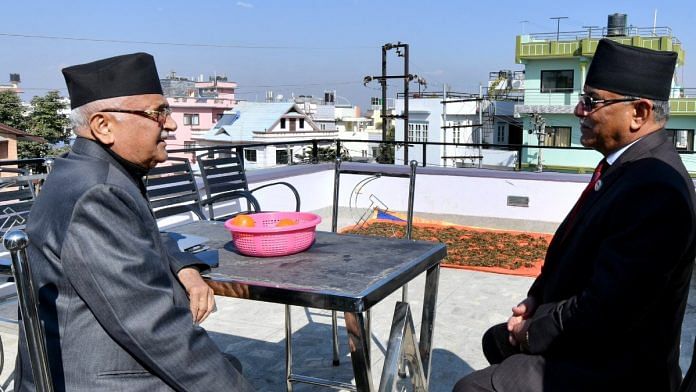New Delhi: The return of Maoist leader Pushpa Kamal Dahal as Prime Minister of Nepal is ‘unlikely’ to affect Kathmandu’s energy relationship with New Delhi, ThePrint has learnt.
Dahal, who still goes by his nom de guerre ‘Prachanda’, was sworn in as the Nepal PM for the third time Monday after his party, the Communist Party of Nepal-Maoist Centre (CPN-MC), exited an alliance with the Nepali Congress and joined forces with the Communist Party of Nepal (Unified Marxist–Leninist) (CPN-UML).
Some experts, however, claim that the CPN-UML chairman and former PM, K. P. Sharma Oli, is in the driver’s seat as his party enjoys the highest number of seats in the alliance.
Currently, Prachanda’s coalition has the support of 165 lawmakers out of the 275-member House of Representatives. CPN-UML holds 78 seats, CPN-MC 32 and five other smaller parties hold the remaining. Prachanda’s victory will only be sealed after he wins a vote of trust from the lower house within 30 days of his swearing-in.
“Without the support of K.P. Sharma Oli’s UML party, he (Dahal) has no ground to stand on. He is reduced to being very much a lame-duck prime minister and Oli’s puppet,” Rakesh Sood, who served as Ambassador to Nepal from 2008 to 2011, told ThePrint.
Some analysts say the reunification of the two Communist parties has got China “smiling across the Himalayas”.
However, two former diplomats told ThePrint that this may not be all that disadvantageous for India’s energy relationship with Nepal, considering that many long-pending hydropower projects only saw progress when CPN-UML or CPN-MC were at the helm of power.
As China and India compete for influence in Nepal, the new leadership can be expected to continue “playing to both sides”, they added.
Also Read: India, Nepal need to address ‘issues left by history’, says ‘Prachanda’
Nepal-India power cooperation
India and Nepal’s energy relationship dates back to 1971 when the two neighbours signed a power exchange agreement. There are over 20 transmission lines — ranging from 11 kV, 33 kV to 132 kV — being used for power exchange between the two countries.
However, there have been times when power shortages in India have hurt supply in Nepal, especially in the dry winter season (December-April) when hydropower plants have scarce water to draw from. The two countries, though, continue to seek new avenues of power cooperation.
In October 2014, the Modi government and the then Nepali Congress-led government, with Sushil Koirala as PM, inked a power trade agreement that sought to create new vistas of energy cooperation.
Some hydropower projects have also been shifted from Chinese to Indian companies. For example, the contract for the 750MW West Seti hydropower project was handed over to India’s National Hydroelectric Power Company Ltd earlier this year. In 2012, Nepal had signed an MoU with the China Three Gorges Corporation to develop the project.
“India won’t buy electricity from the West Seti hydro project if it’s built by Chinese companies so I am going to give it to India,” previous Prime Minister Sher Bahadur Deuba had said during an election rally in May.
According to Sood, the new government in Kathmandu will not affect Nepal’s energy exports to India. “Nepal earned $11 million for selling excess power to India from June to December. Also, the Arun-3 Hydro Electric project, for which Oli and Modi laid the foundation stone in 2018, is likely to be operational by next year and will be a major export earner for Nepal and also benefit India,” he told ThePrint.
The $1.6 billion Arun III, a run-of-the river-type hydro-electric project, seeks to have a capacity of a whopping 900MW and is slated to be completed in financial year 2023-24. When completed, it will be the largest hydropower plant in South Asia. In May 2018, Modi and Oli laid the foundation stone for the plant in Tumlingtar area.
“During K.P. Sharma Oli’s previous stint as PM, some long-pending projects took off under him like the Arun-3 hydropower project — something that didn’t see progress even under Nepali Congress governments,” Manjeev Puri, former Ambassador to Nepal from 2017-19, pointed out.
Another big ticket joint project in the works is Arun-4, being developed by state-owned Nepal Electricity Authority and India’s Satluj Jal Vidyut Nigam Limited, which seeks to have a capacity of 695MW.
‘Playing both sides’
Reports say the previous Deuba-led government was pursuing stronger ties with India and the US, while Prachanda’s return is now expected to give new momentum to Nepal’s relationship with China.
Asked about China and India’s efforts to gain influence in Nepal, be it through Beijing’s Belt and Road Initiative (BRI) or New Delhi’s investments in the Himalayan nation’s hydropower sector, experts said the new government in Kathmandu will continue to play both sides.
“If we (India) could play non-aligned between the US and the USSR during the Cold War or more recently, between Russia and the West, we should understand that India’s neighbors, including Nepal, will do the same between India and China,” Sood said.
He, however, offered a caveat: “I’m sure Kathmandu knows that there is a limit to how far they can take it without it backfiring.”
Asked about Nepal’s participation in the BRI, Puri called it “marginal” by the standards of other countries’ participation in the project.
“Nepal has also been careful not to fall into any debt traps with China unlike other regional players like Sri Lanka,” he said, adding that the new Nepali leadership is likely to continue following policies of “non-alignment” and “political equidistance” between India and China.
(Edited by V. S. Chandrasekar)
Also Read: From power trade to rail connectivity – India, Nepal work to revamp ties after map row



